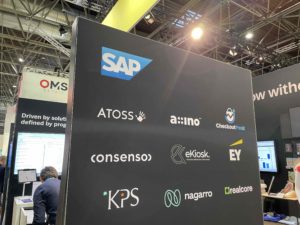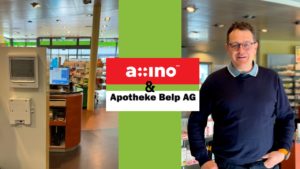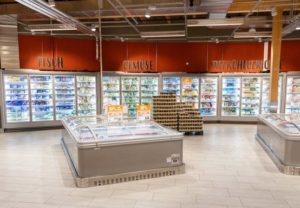Source: Refrigerated & Frozen Foods
IoT solution helps grocery retailers remotely monitor temperature of perishables
For the first time, grocery retailers are able to remotely and non-invasively monitor the product temperature of perishable food in refrigerated equipment.
The fresh food category—comprised of fruits, vegetables, meat, fish, dairy and baked goods—accounts for about 40% of grocery retail revenue. These food offerings are a strong driver for grocery chain customer traffic and loyalty. Fresh food is fiercely competitive among retailers and is becoming even more critical.
Traditional grocers are being challenged by increases in sales from convenience stores and big-box retailer home delivery services.
McKinsey & Co., New York, released research from a Pan-European benchmarking survey of 23,000 grocery shoppers. Results indicated low prices and frequent promotions were attributes that increase customer satisfaction, but food quality and freshness ranked as consumers’ highest concerns. According to the research, grocers can boost sales by as much as 10% by improving fresh food practices and policies.
“Quality is no longer a nice-to-have as before; it is a critical necessity for retailers to defend their market position. In response to increased demand for fresh food, most Swiss retailers have added 40% more refrigerated coolers to their stores within the past five years,” says Ihab Hourani, chief technology officer for Axino Solutions GmbH, Germany.
However, providing fresh food is a complex operation for grocery chains, as prices are volatile, suppliers are fragmented and quality control processes of perishable products are laborious and costly. The process to measure temperature to address cold chain compliance regulations and ensure fresh goods for consumers has primarily been accomplished by manually checking and recording temperature readings of refrigerated units and inserting a probe thermometer into food. This process, though labor intensive and wasteful, is the accepted industry norm.
Challenge
- Replace invasive manual core temperature monitoring of food.
- Create retrofit solutions to work across legacy systems.
- Pilot new technology to resolve industry issues.
Business value
- Remotely access and review temperature measurements.
- Ensure quality fresh food for customers.
- Reduce food waste and lost revenue.
Data-driven freshness in food retailing
Axino Solutions is a global leader in providing communication solutions and services. The company designs, implements and operates comprehensive turnkey, customized software Internet of Things (IoT) solutions that help companies fully automate their digitalization processes.
Axino set out to develop an automated and continuous temperature monitoring system with innovative technology that could disrupt retail cold chain refrigeration. Axino and Zurich University of Applied Sciences, Switzerland, conducted measurement research and tests on six categories of fresh food to detect their specific heat signatures and convection attributes, and determine the optimal core temperature for freshness for each product, as well as evaluate products in a variety of real-world instances (e.g. packed in plastic, unpacked, sliced). In addition, researchers ran tests utilizing robotic arms to simulate the operating mode of customers opening doors to refrigerated chests and freezers.
After extrapolating the comprehensive research data, Axino developed a bespoke artificial intelligence algorithm that is said to guarantee the core temperature of any food group item within 1°C. Axino’s digital measurement software and hardware components, combined with LoRa devices from Semtech Corp., Camarillo, Calif., are able to wirelessly detect and communicate the core temperature of a product with sensors placed inside coolers up to one meter away from the actual food items.
“The detection process is like magic. There is no other manufacturer who can predict core temperature of food this way. It’s truly a disruptive innovation,” adds Hourani.
IoT solutions
Axino leveraged Semtech’s LoRa devices and the LoRaWAN open protocol for its Axino.IoT.FoodSafety temperature monitoring and asset quality management solution.
For the first time, grocery retailers are able to remotely and non-invasively monitor the product temperature of perishable food in refrigerated equipment. By implementing Axino’s connected temperature monitoring solution with LoRa-enabled sensors, gateways and LoRaWAN-based connectivity, grocers can improve the safety and security of fresh food while reducing food waste and lost revenues.
“LoRa-based devices were the perfect choice. They offer low energy consumption, built-in security functionality, low implementation and operating costs, suitability for battery-operated sensors and reliable public and private network performance,” says Hourani.
Using LoRa chipsets, Axino’s solution (comprised of custom software, hardware and a back-end system) provides easy-to-understand, real-time and historical temperature data on a web-based dashboard or mobile device. The visual display includes interactive charts and customized mapping of sensor locations. Alert notifications are built into the system to send warnings when sets of pre-defined temperature rules or thresholds are exceeded.
Migros, a Switzerland-based grocery retailer, rakes in annual sales over $28 billion, and is owned by more than 2 million cooperative members.
Like the majority of supermarkets in the world, Migros grocery retailers and restaurants are operated with cooling and freezing units acquired from multiple manufacturers. Axino’s patented retrofit and vendor-agnostic temperature monitoring system works across all cooling systems operating throughout Europe.
Migros initially implemented the Axino.IoT.FoodSafety quality management system in stores within the Zurich region. Each Migros store involved in the initial proof of concept deployed, on average, 70-100 sensors – one magnet-attached sensor for each cooling unit – and a single gateway providing connectivity for the entire retail facility.
“Not only does our solution guarantee fresher food, but [also] employees are able to spend more time taking care of other tasks. If it takes someone even one hour per day to manually record temperature readings and you multiply that by hundreds of stores, the savings start to add up fast. Migros is projected to have ROI within less than 12 months,” says Hourani.
Migros’ staff were able to remotely access and review temperature developments from a smartphone, tablet or computer. The plug-and-play solution reduced staff workload, allowing employees to focus on managing inventory and other responsibilities. Axino’s solution also enhanced Migros’ quality assurance capabilities and Hazard Analysis and Critical Control Point (HACCP) processes. Based on these results, Migros plans to implement the Axino.IoT.FoodSafety solution in more than 800 stores by 2020.
Be Cool, Stay Fresh – Axino
Axino combines IoT sensor technology with patented AI algorithms to ensure freshness while reducing energy consumption. By digitizing and automating quality management process, we take the guess work out of food safety (HACCP) compliance. Learn more at www.axino.ai







